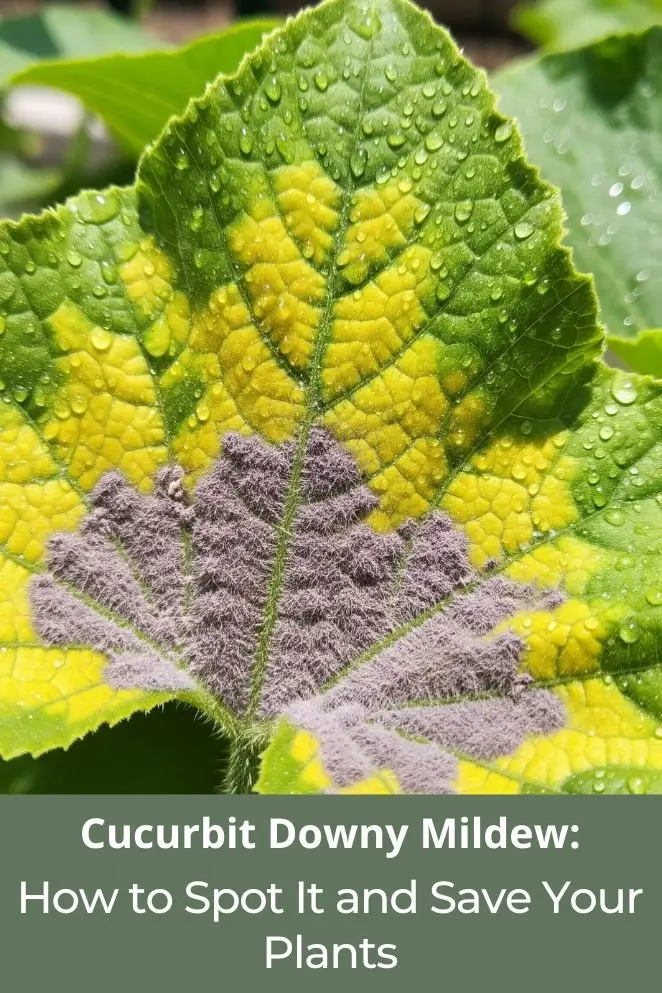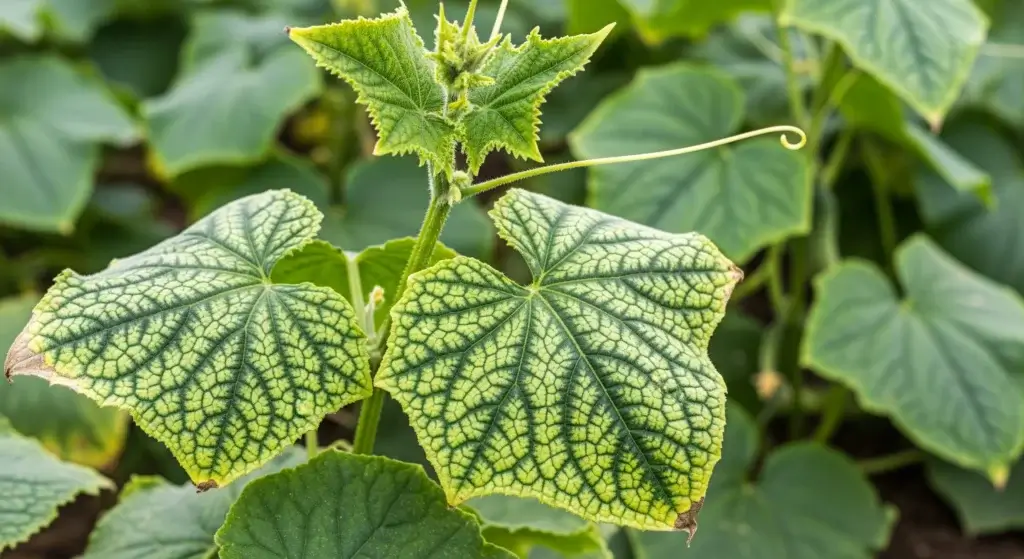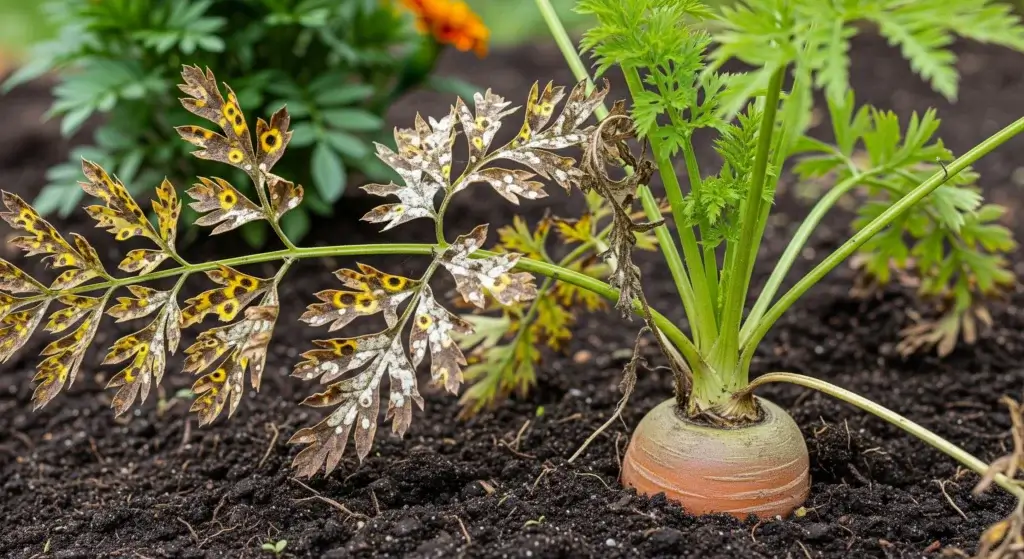
Growing cucurbits — cucumbers, melons, squash, pumpkins, and watermelons — is awesome, but nothing ruins the party faster than cucurbit downy mildew.
This nasty fungus lookalike can wipe out your plants in just weeks if you ignore it.
Catching it early and managing it right is the difference between a huge harvest and total heartbreak.
Learning about this disease isn’t just damage control for today’s crop — it’s about keeping your garden or farm safe long-term.
Think of it as leveling up your plant defense system so you can keep enjoying cucurbits year after year.
What is Cucurbit Downy Mildew?
Pseudoperonospora cubensis is an oomycete (so — not a true fungus, more like a nasty algal cousin) that zeroes in on cucurbits — cucumbers, melons, squash, pumpkins, watermelons.
It spreads fast in the right weather and can strip leaves off vines in weeks, turning a lush patch into a sad skeleton before you can say “snack time.”
Why Cucurbit Downy Mildew Matters
This disease wrecks both big farms and backyard gardens — millions lost commercially and entire home seasons gone in an instant.
Even worse, it can evolve resistance to some fungicides, so the old fixes don’t always work.
Gardeners often tell the same story: one week everything’s green, two weeks later it’s defoliated — which is why staying alert and using updated management is clutch.
- Read also: Saving Cucumbers from Downy Mildew: A Step-by-Step Guide
- Read also: Spot the Difference: How to Identify Fungal vs Bacterial Plant Diseases
Identifying Cucurbit Downy Mildew: Key Symptoms and Signs
Catching cucurbit downy mildew early is everything — miss the first signs, and you might as well wave goodbye to your vines.
The tricky part? Symptoms shift a bit depending on whether you’re looking at cucumbers, melons, squash, pumpkins, or watermelons.
But there are classic giveaways if you know where to look.
Primary Leaf Symptoms
This disease is a leaf bully — it doesn’t care about fruit or stems.
Within 3–12 days of infection, you’ll spot pale green to yellow patches on the top of leaves. That’s your first clue.
On Cucumbers and Melons:
- Look for angular yellow-to-brown spots that line up perfectly with the veins, almost like someone drew geometric shapes on the leaf.
- They start pale, then brown up fast.
On Squash and Pumpkins:
- Tiny, bright yellow flecks scatter across the leaf like confetti.
- They get bigger and turn brown, but they’re less boxy than cucumber symptoms.
On Watermelons:
- Wild card alert — watermelon symptoms are messy and unpredictable.
- You’ll usually see blotchy yellow patches that don’t follow patterns, which makes them easy to confuse with other leaf diseases.
The Telltale “Downy” Sign
Here’s the dead giveaway: flip a leaf over in the morning when dew is still clinging, and you might see dark, fuzzy, gray-brown gunk under the spots.
That’s the pathogen’s “spore factory,” cranking out millions of little troublemakers.
If you catch that downy fuzz, congratulations (and condolences) — you’ve officially got cucurbit downy mildew.
Disease Progression Patterns
Think of it like a four-stage boss fight:
- Early Stage: little yellow-green dots show up on top of leaves.
- Active Stage: spots expand, brown up, and fuzzy growth appears underneath.
- Advanced Stage: leaves look fried, and some start dropping.
- Final Stage: the plant defoliates completely, leaving your poor cucumbers or pumpkins sunburnt and vulnerable.
Environmental Conditions That Favor Disease Development
To beat cucurbit downy mildew, you’ve gotta know what kind of weather it loves — because this pathogen is picky.
When the environment lines up just right, it goes full-on viral, spreading faster than a meme.
Temperature Requirements
This disease thrives in “chill but not too chill” weather, around 60–75°F (15–24°C).
That’s its sweet spot for infection and spore production. Once temps hit 85°F+ (29°C), the pathogen slows down, and if it freezes? Game over — the mildew can’t survive. So yeah, it’s kind of a fair-weather villain.
Moisture and Humidity Demands
Here’s the real kicker: mildew is obsessed with moisture. It needs:
- Leaves to stay wet for at least 4–6 hours (hello, overnight dew).
- Relative humidity above 85% to really get going.
- Free water sitting on leaves from rain, irrigation, or morning dew.
That’s why it often shows up like a jump scare right after humid, sticky weather — the spores germinate, invade, and suddenly your plants look like they’ve been hit overnight.
Seasonal Patterns
The mildew has seasonal habits, too:
- Down south: it usually pops up after May 1st.
- Up north: it sneaks in later, after mid-August.
- Everywhere: late summer and early fall are prime time, when cool-ish nights and damp mornings set the perfect stage.
Prevention Strategies: Your First Line of Defense
Stopping cucurbit downy mildew before it starts is way easier (and cheaper) than trying to fight it once it’s taken over.
Think of prevention as locking your doors at night — way better than dealing with a break-in.
Resistant Varieties
There aren’t miracle plants that are 100% immune, but some cucumber varieties are pretty tough against downy mildew. When shopping seeds, check for:
- Resistance ratings in seed catalogs (they’ll brag about it if the variety is good).
- Local extension service data — they test what actually works in your area.
- Recent trial results, because the mildew is sneaky and keeps evolving.
Cultural Control Practices
Site Selection and Preparation
Pick a spot with solid drainage and plenty of air circulation.
Avoid low, swampy areas where humidity hangs out.
Space your plants so they don’t smother each other — mildew thrives in crowded, damp conditions.
Water Management
Drip irrigation or soaker hoses = chef’s kiss. They keep leaves dry while watering roots.
Skip overhead watering, especially at night, or you’re basically setting out a mildew buffet.
Always water early enough so leaves dry before dark.
Crop Rotation
Don’t keep planting cucurbits in the same spot year after year.
That’s like inviting the pathogen back with a welcome mat.
Rotate with crops it can’t infect, like cereals or beans, and give cucurbits at least 2–3 years off before returning to the same soil.
Sanitation Measures
Think of this as cleaning up after a messy roommate:
- Yank and destroy infected plants right away. Don’t compost them — that’s just mildew daycare.
- Avoid walking through your plants when they’re wet, or you’ll spread spores like muddy footprints across the carpet.
- Clean your tools and gear between uses.
- Pull out volunteer cucurbit plants (those random stragglers from last season) — they can secretly host the disease and spread it again.
Treatment Options: Chemical and Organic Solutions
Okay, so let’s say you did all the prevention stuff but downy mildew still crashes your garden party.
Don’t panic — you’ve still got weapons.
The trick? Act fast, pick the right tools, and use them correctly.
Conventional Fungicide Programs
Modern fungicides are like a squad of specialized superheroes.
But here’s the catch: if you keep sending the same hero out over and over, the villain (mildew) figures out their moves.
That’s why we mix it up with different “modes of action.”
Most Effective Conventional Fungicides
- Orondis (oxathiapiprolin): MVP status right here. Usually mixed with other fungicides for max effect.
- Omega (fluazinam): Awesome if you use it before the mildew shows up.
- Ranman (cyazofamid): Systemic — which means it moves inside the plant. Bonus: has some curative power if you catch it early.
- Zing! (ametoctradin): A strong shield when combined with other products.
Application Strategies
- Preventive: Start spraying before the disease shows up. Think of it as sunscreen for your plants. Every 7 days for cucumbers, every 10 days for the others.
- After detection: Step it up — 5 days for cucumbers, 7 days for others.
- Rotation: Always switch it up so the mildew doesn’t get wise and build resistance.
Organic and Biopesticide Options
If you’re going the organic route, you’ve still got solid tools — you just have to be more consistent and on top of it.
Copper-Based Products
- Widely available, and yes, organic-approved.
- Work best if you spray before the disease shows up.
- Can sometimes burn your plants if conditions are off, so don’t overdo it.
Biological Control Agents
- Stuff like Bacillus species (yep, “good bacteria”).
- They basically crowd out the bad guy mildew or make it harder for it to spread.
- Work best as part of a “team effort” with other organic sprays.
Application Considerations for Organic Products
- Expect to spray more often (every 5–7 days).
- Start early in the season. Don’t wait until the mildew’s already got a foothold.
- Tank mix when possible — combo moves are always stronger.
- Keep an eye on the weather, because timing is everything.
Integrated Pest Management Approach
The best long-term strategy isn’t just one thing — it’s the combo platter:
- Pick varieties that can handle downy mildew.
- Use cultural practices (spacing, watering smart, etc.) to keep plants healthier.
- Scout your plants like a detective for early signs.
- Layer in fungicide programs that fit your local conditions.
- Always rotate products so mildew doesn’t adapt like some video game boss.
Advanced Management Techniques
cucurbit downy mildew is sneaky. It keeps evolving, like that one gamer who always learns new hacks no matter what rules you set.
That’s why advanced techniques aren’t just “extra credit” — they’re your best bet for staying one step ahead.
Precision Application Timing
Instead of just spraying on a schedule and hoping for the best, smart growers use weather-based forecasting models.
Think of them like a weather app, but for disease:
- They track temperature and humidity (because mildew LOVES cool, damp vibes).
- They measure leaf wetness (yep, your plants having dew on them counts).
- They factor in wind and spore travel (those tiny spores can ride the breeze like dust).
- They even pull from past outbreaks to predict what’s coming.
By timing sprays with these predictions, you save time, money, and chemicals — while still nailing the mildew before it strikes.
It’s like setting traps right where you know the villain’s gonna show up.
- Read also: 10 Essential Tips for Winter Garden Pest and Disease Prevention
- Read also: Fusarium Wilt in Vegetables: Causes and Solutions
Resistance Management Strategies
Here’s the scary part: if you keep using the same fungicide over and over, mildew basically levels up and becomes immune.
To stop that, you need a solid resistance management game plan:
- Mode of action diversity: Rotate products so you’re not giving mildew the same fight every time.
- Tank mixing: Pair up a systemic fungicide (works inside the plant) with a protectant (shields the surface).
- Application limits: Respect the “max use” rules — pushing past them just speeds up resistance.
- Monitoring: If you notice your usual go-to spray isn’t working as well, that’s your red flag.
Integrated Monitoring Systems
This is where you become part scientist, part detective:
- Field scouting: Walk your garden or fields regularly, especially after rainy or humid stretches.
- Spore traps: Yep, people actually set up regional networks that track spores in the air — like pollen alerts but for mildew.
- Weather tracking: Keep tabs on conditions that scream “perfect mildew day.”
- Record keeping: Write down what you sprayed, when, and how it worked. Next season, you’ll thank yourself for the notes.
Conclusion: Building Long-Term Success
Beating cucurbit downy mildew isn’t about winning once — it’s about staying in the game season after season.
This disease is like that rival who keeps coming back stronger, so you’ve got to be smarter, not just tougher.
The secret sauce? Mix it up: plant resistant varieties, use smart watering and spacing, rotate your crops, keep an eye on the weather, and only spray when it actually counts.
It’s not about drowning your plants in chemicals, it’s about strategy — kind of like leveling up in a game by playing smart, not just button-mashing.



